Satas D., Tracton A.A. (ed.). Coatings Technology Handbook
Подождите немного. Документ загружается.

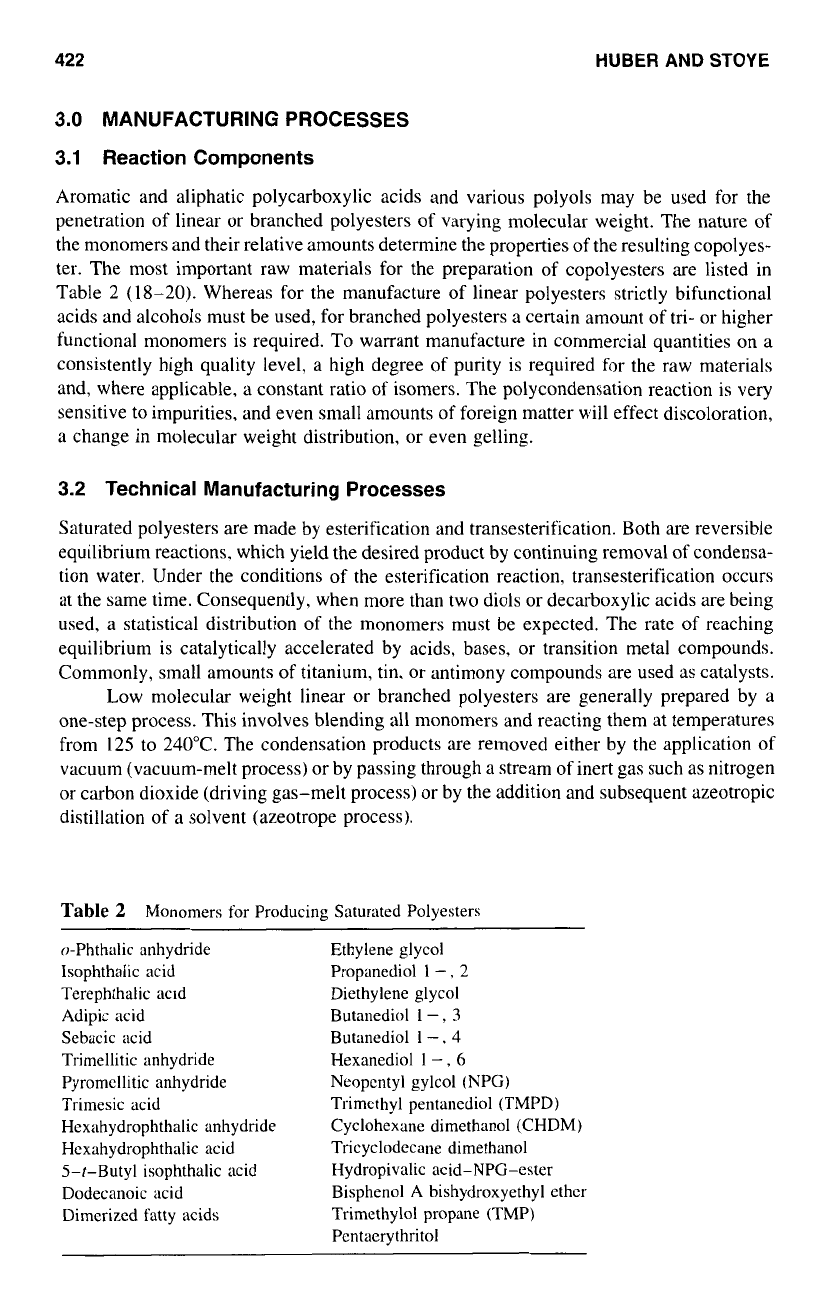
422
HUBER
AND
STOYE
3.0
MANUFACTURING
PROCESSES
3.1
Reaction Components
Aromatic and aliphatic polycarboxylic acids and various polyols may be used for the
penetration of linear or branched polyesters of varying molecular weight. The nature of
the monomers and their relative amounts determine the properties
of
the resulting copolyes-
ter. The most important raw materials for the preparation of copolyesters are listed in
Table 2 (18-20). Whereas for the manufacture of linear polyesters strictly bifunctional
acids and alcohols must be used, for branched polyesters a certain amount of tri- or higher
functional monomers is required. To warrant manufacture in commercial quantities on a
consistently high quality level,
a
high degree
of
purity is required for the raw materials
and, where applicable, a constant ratio
of
isomers. The polycondensation reaction is very
sensitive to impurities, and even small amounts of foreign matter will effect discoloration,
a change in molecular weight distribution, or even gelling.
3.2
Technical Manufacturing Processes
Saturated polyesters are made by esterification and transesterification. Both are reversible
equilibrium reactions. which yield the desired product by continuing removal
of
condensa-
tion water. Under the conditions of the esterification reaction, transesterification occurs
at the same time. Consequently, when more than two diols or decarboxylic acids are being
used, a statistical distribution of the monomers must be expected. The rate of reaching
equilibrium is catalytically accelerated by acids, bases, or transition metal compounds.
Commonly, small amounts
of
titanium, tin, or antimony compounds are used as catalysts.
Low molecular weight linear or branched polyesters are generally prepared by a
one-step process. This involves blending all monomers and reacting them at temperatures
from 125 to 240°C. The condensation products are removed either by the application
of
vacuum (vacuum-melt process) or by passing through a stream of inert gas such as nitrogen
or carbon dioxide (driving gas-melt process) or by the addition and subsequent azeotropic
distillation of a solvent (azeotrope process).
Table
2
Monomers for Producing Saturated Polyesters
~~~ ~~
o-Phthalic anhydride
Isophthalic acid
Terephthalic acld
Adipic acid
Sebacic acid
Trimellitic anhydride
Pyromellitic anhydride
Trimesic acid
Hexahydrophthalic anhydride
Hexahydrophthalic acid
5-t-Butyl isophthalic acid
Dodecanoic acid
Dimerized fatty acids
Ethylene glycol
Propanediol
1
-
,
2
Diethylene glycol
Butanediol
1
-
,
3
Butanediol
1
-
,
4
Hexanediol
1
-
,
6
Neopcntyl gylcol (NPG)
Trimethyl pentanediol (TMPD)
Cyclohexane dimethanol (CHDM)
Tricyclodecane dimethanol
Hydropivalic acid-NPG-ester
Bisphenol A bishydroxyethyl ether
Trimethylol propane (TMP)
Pcntaerythritol
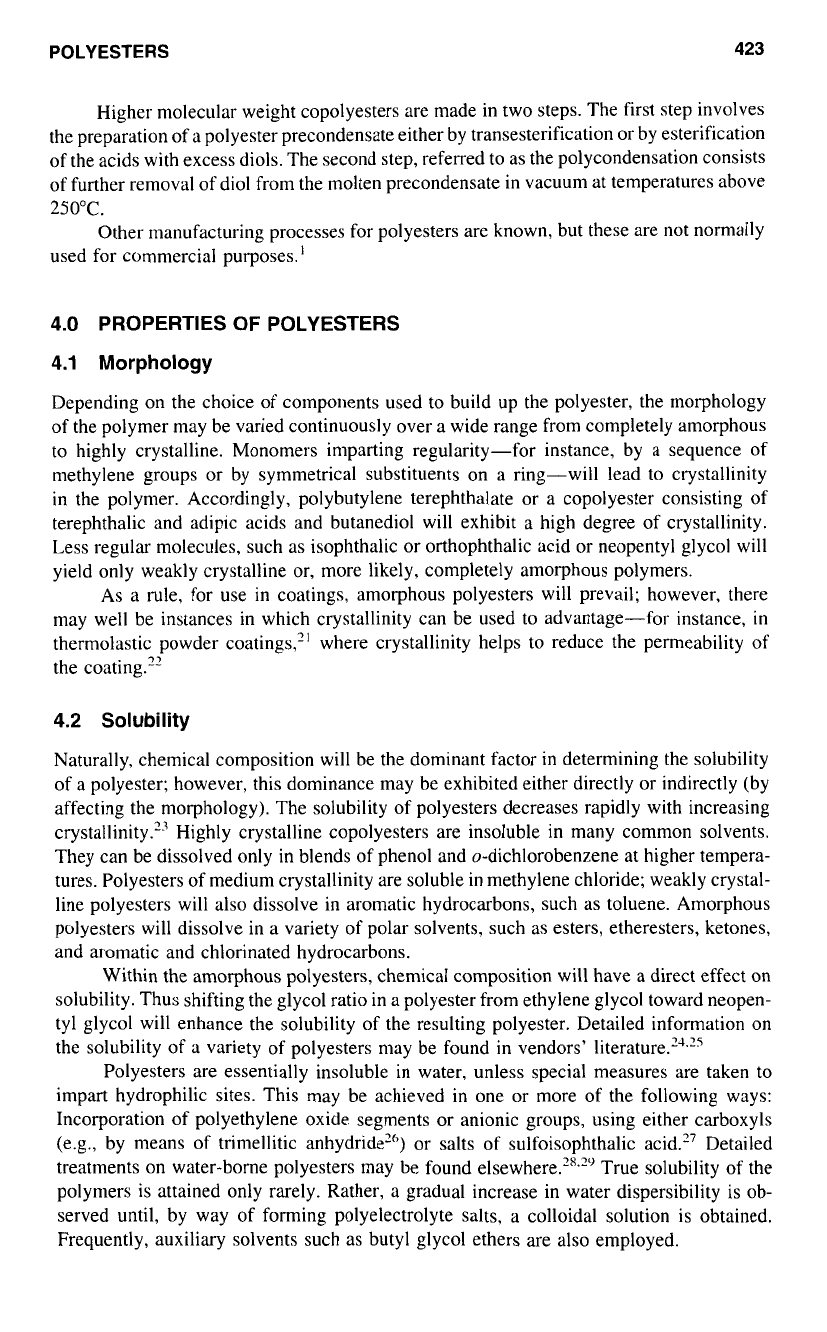
POLYESTERS
423
Higher molecular weight copolyesters are made in two steps. The first step involves
the preparation of a polyester precondensate either by transesterification or by esterification
of
the acids with excess diols. The second step, referred to as the polycondensation consists
of further removal of diol from the molten precondensate in vacuum at temperatures above
250°C.
Other manufacturing processes for polyesters are known, but these are not normally
used for commercial purposes.’
4.0
PROPERTIES OF POLYESTERS
4.1 Morphology
Depending on the choice
of
components used to build up the polyester, the morphology
of the polymer may be varied continuously over a wide range from completely amorphous
to
highly crystalline. Monomers imparting regularity-for instance, by a sequence of
methylene groups or by symmetrical substituents on a ring-will lead to crystallinity
in the polymer. Accordingly, polybutylene terephthalate or
a
copolyester consisting of
terephthalic and adipic acids and butanediol will exhibit
a
high degree
of
crystallinity.
Less regular molecules, such
as
isophthalic or orthophthalic acid or neopentyl glycol will
yield only weakly crystalline or, more likely, completely amorphous polymers.
As
a
rule, for use
in
coatings, amorphous polyesters will prevail; however, there
may well be instances in which crystallinity can be used to advantage-for instance,
in
thermolastic powder coatings,” where crystallinity helps to reduce the permeability
of
the coating.”
4.2
Solubility
Naturally, chemical composition will be the dominant factor
in
determining the solubility
of
a
polyester; however, this dominance may be exhibited either directly or indirectly (by
affecting the morphology). The solubility of polyesters decreases rapidly with increasing
crystallinity.’3 Highly crystalline copolyesters are insoluble in many common solvents.
They can be dissolved only in blends of phenol and o-dichlorobenzene at higher tempera-
tures. Polyesters of medium crystallinity are soluble in methylene chloride; weakly crystal-
line polyesters will
also
dissolve in aromatic hydrocarbons, such
as
toluene. Amorphous
polyesters will dissolve in
a
variety of polar solvents, such as esters, etheresters, ketones,
and aromatic and chlorinated hydrocarbons.
Within the amorphous polyesters, chemical composition will have
a
direct effect on
solubility. Thus shifting the glycol ratio in
a
polyester from ethylene glycol toward neopen-
tyl glycol will enhance the solubility of the resulting polyester. Detailed information on
the solubility of
a
variety of polyesters may be found in vendors’ literature.”.”
Polyesters are essentially insoluble in water, unless special measures are taken to
impart hydrophilic sites. This may be achieved in one or more of the following ways:
Incorporation of polyethylene oxide segments or anionic groups, using either carboxyls
(e.g., by means of trimellitic anhydride”) or salts of sulfoisophthalic acid.” Detailed
treatments on water-borne polyesters may be found elsewhere.”,” True solubility
of
the
polymers is attained only rarely. Rather,
a
gradual increase in water dispersibility is ob-
served until, by way of forming polyelectrolyte salts, a colloidal solution is obtained.
Frequently, auxiliary solvents such
as
butyl glycol ethers are also employed.
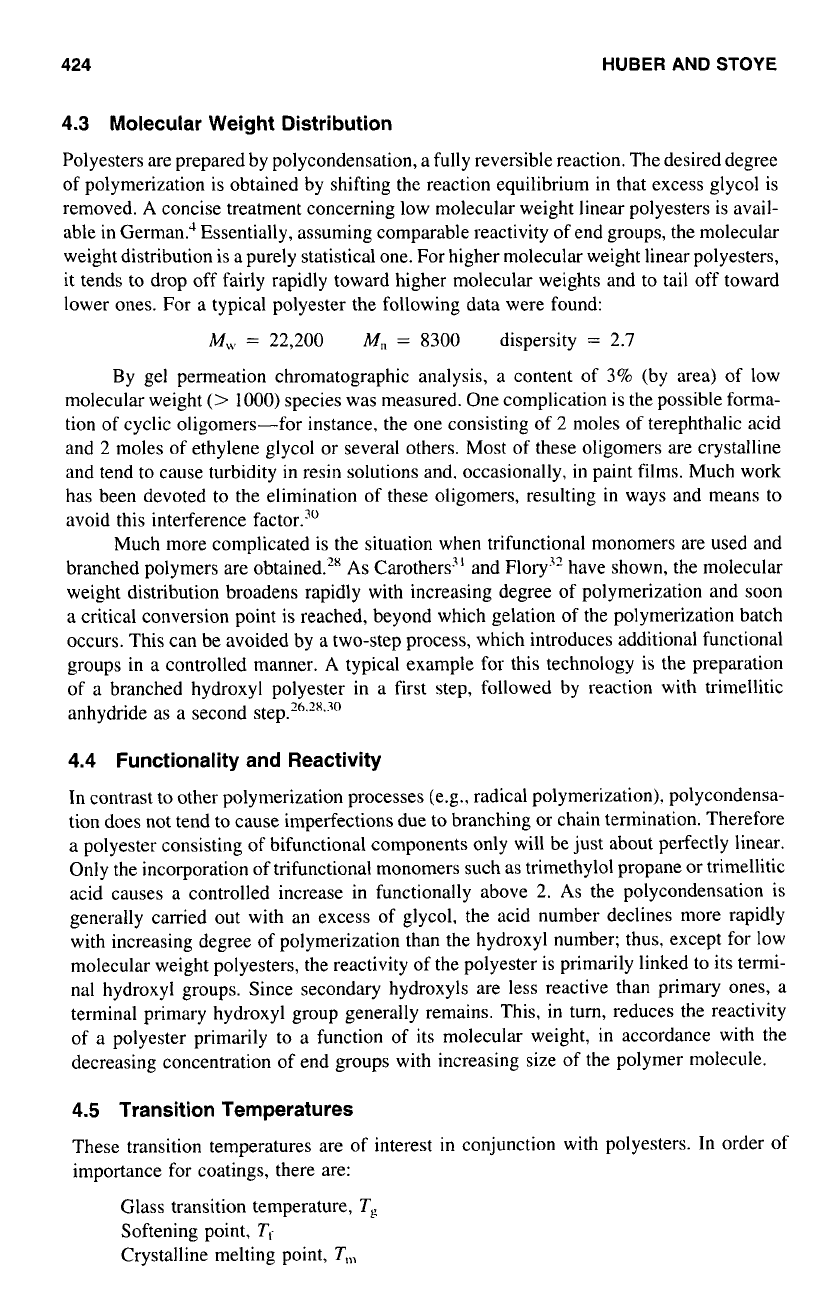
424
HUBERANDSTOYE
4.3
Molecular Weight Distribution
Polyesters are prepared by polycondensation, a fully reversible reaction. The desired degree
of polymerization is obtained by shifting the reaction equilibrium
in
that excess glycol is
removed.
A
concise treatment concerning low molecular weight linear polyesters is avail-
able in German.' Essentially, assuming comparable reactivity of end groups, the molecular
weight distribution is
a
purely statistical one. For higher molecular weight linear polyesters,
it tends to drop off fairly rapidly toward higher molecular weights and to tail
off
toward
lower ones. For a typical polyester the following data were found:
M,,.
=
22,200
M,,
=
8300 dispersity
=
2.7
By gel permeation chromatographic analysis,
a
content of 3% (by area)
of
low
molecular weight
(>
1000)
species was measured. One complication is the possible forma-
tion of cyclic oligomers-for instance, the one consisting of
2
moles of terephthalic acid
and
2
moles of ethylene glycol or several others. Most of these oligomers are crystalline
and tend to cause turbidity in resin solutions and. occasionally, in paint films. Much work
has been devoted
to
the elimination of these oligomers, resulting in ways and means
to
avoid this interference factor.3u
Much more complicated is the situation when trifunctional monomers are used and
branched polymers are obtained.lx As Carothers3' and Flory3' have shown, the molecular
weight distribution broadens rapidly with increasing degree of polymerization and soon
a
critical conversion point is reached, beyond which gelation
of
the polymerization batch
occurs. This can be avoided by
a
two-step process, which introduces additional functional
groups in
a
controlled manner.
A
typical example for this technology is the preparation
of a branched hydroxyl polyester in a first step, followed by reaction with trimellitic
anhydride as a second step.'",'x,30
4.4
Functionality and Reactivity
In contrast to other polymerization processes (e.g., radical polymerization). polycondensa-
tion does not tend
to
cause imperfections due to branching or chain termination. Therefore
a
polyester consisting
of
bifunctional components only will be just about perfectly linear.
Only the incorporation of trifunctional monomers such
as
trimethylol propane or trimellitic
acid causes a controlled increase in functionally above
2.
As
the polycondensation is
generally carried out with an excess of glycol, the acid number declines more rapidly
with increasing degree of polymerization than the hydroxyl number; thus, except for
IOW
molecular weight polyesters, the reactivity of the polyester is primarily linked to its termi-
nal hydroxyl groups. Since secondary hydroxyls are less reactive than primary ones, a
terminal primary hydroxyl group generally remains. This, in turn, reduces the reactivity
of a polyester primarily
to
a function of its molecular weight, in accordance with the
decreasing concentration of end groups with increasing size of the polymer molecule.
4.5
Transition Temperatures
These transition temperatures are of interest in conjunction with polyesters. In order
of
importance for coatings, there are:
Glass transition temperature,
Tg
Softening point,
T,-
Crystalline melting point,
T,,,
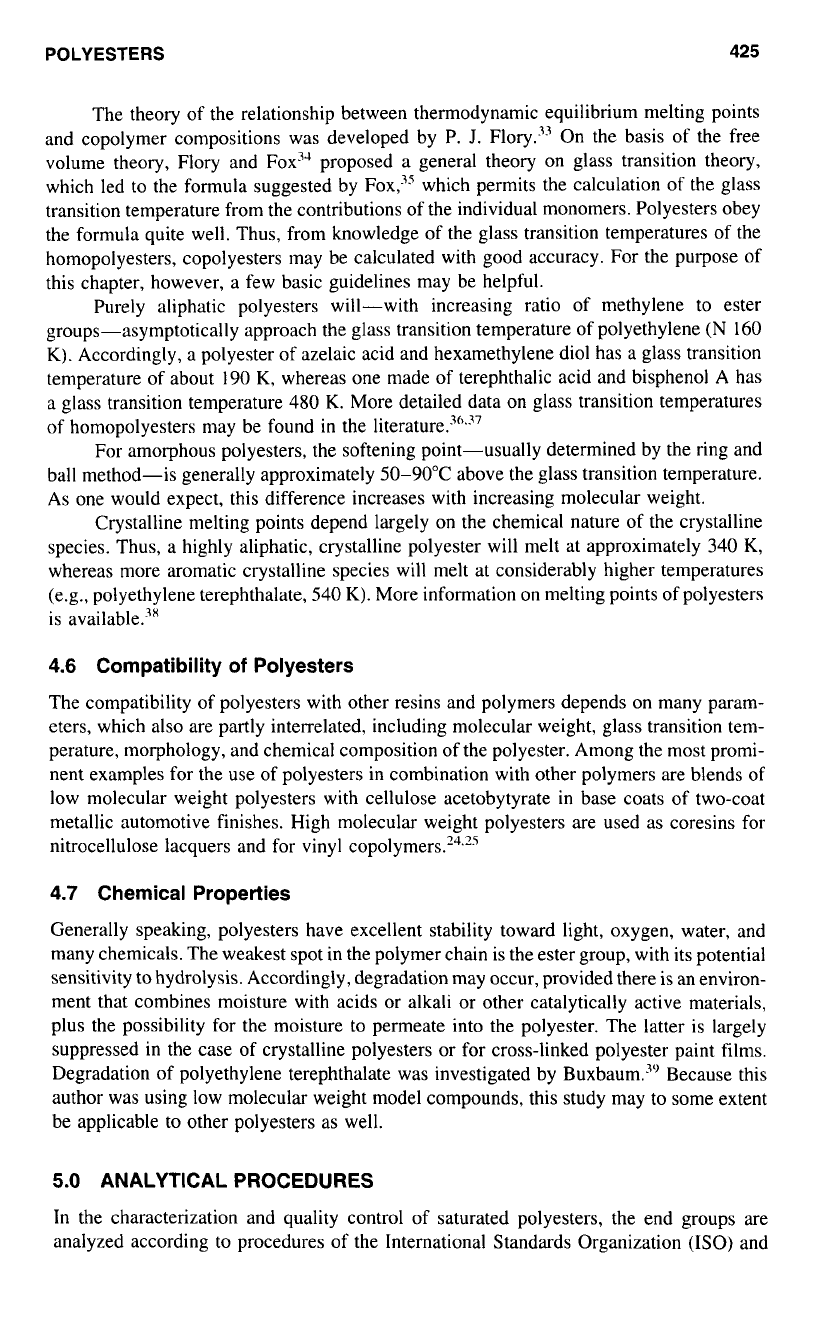
POLYESTERS
425
The theory of the relationship between thermodynamic equilibrium melting points
and copolymer compositions was developed by P.
J.
F10ry.'~ On the basis of the free
volume theory, Flory and Fox34 proposed a general theory
on
glass transition theory,
which led
to
the formula suggested by Fox," which permits the calculation of the glass
transition temperature from the contributions of the individual monomers. Polyesters obey
the formula quite well. Thus, from knowledge of the glass transition temperatures of the
homopolyesters, copolyesters may be calculated with good accuracy. For the purpose of
this chapter, however, a few basic guidelines may be helpful.
Purely aliphatic polyesters will-with increasing ratio of methylene to ester
groups-asymptotically approach the glass transition temperature of polyethylene
(N
160
K). Accordingly, a polyester of azelaic acid and hexamethylene diol has a glass transition
temperature of about 190
K,
whereas one made
of
terephthalic acid and bisphenol A has
a glass transition temperature
480
K.
More detailed data on glass transition temperatures
of homopolyesters may be found
in
the literat~re.'".~~
For amorphous polyesters, the softening point-usually determined by the ring and
ball method-is generally approximately 50-90°C above the glass transition temperature.
As one would expect, this difference increases with increasing molecular weight.
Crystalline melting points depend largely on the chemical nature
of
the crystalline
species. Thus, a highly aliphatic, crystalline polyester will melt at approximately
340
K,
whereas more aromatic crystalline species will melt at considerably higher temperatures
(e.g.. polyethylene terephthalate,
540
K).
More information on melting points of polyesters
is available.'x
4.6
Compatibility
of
Polyesters
The compatibility
of
polyesters with other resins and polymers depends on many param-
eters, which also are partly interrelated, including molecular weight, glass transition tem-
perature, morphology, and chemical composition of the polyester. Among the most promi-
nent examples for the use
of
polyesters in combination with other polymers are blends of
low molecular weight polyesters with cellulose acetobytyrate in base coats of two-coat
metallic automotive finishes. High molecular weight polyesters are used as coresins for
nitrocellulose lacquers and for vinyl
4.7
Chemical Properties
Generally speaking, polyesters have excellent stability toward light, oxygen, water, and
many chemicals. The weakest spot in the polymer chain is the ester group, with its potential
sensitivity to hydrolysis. Accordingly, degradation may occur, provided there is an environ-
ment that combines moisture with acids or alkali or other catalytically active materials,
plus the possibility for the moisture to permeate into the polyester. The latter is largely
suppressed in the case of crystalline polyesters or for cross-linked polyester paint films.
Degradation of polyethylene terephthalate was investigated by Buxbaum."~ Because this
author was using low molecular weight model compounds, this study may to some extent
be applicable to other polyesters as well.
5.0
ANALYTICAL PROCEDURES
In the characterization and quality control of saturated polyesters, the end groups are
analyzed according to procedures of the International Standards Organization (ISO) and
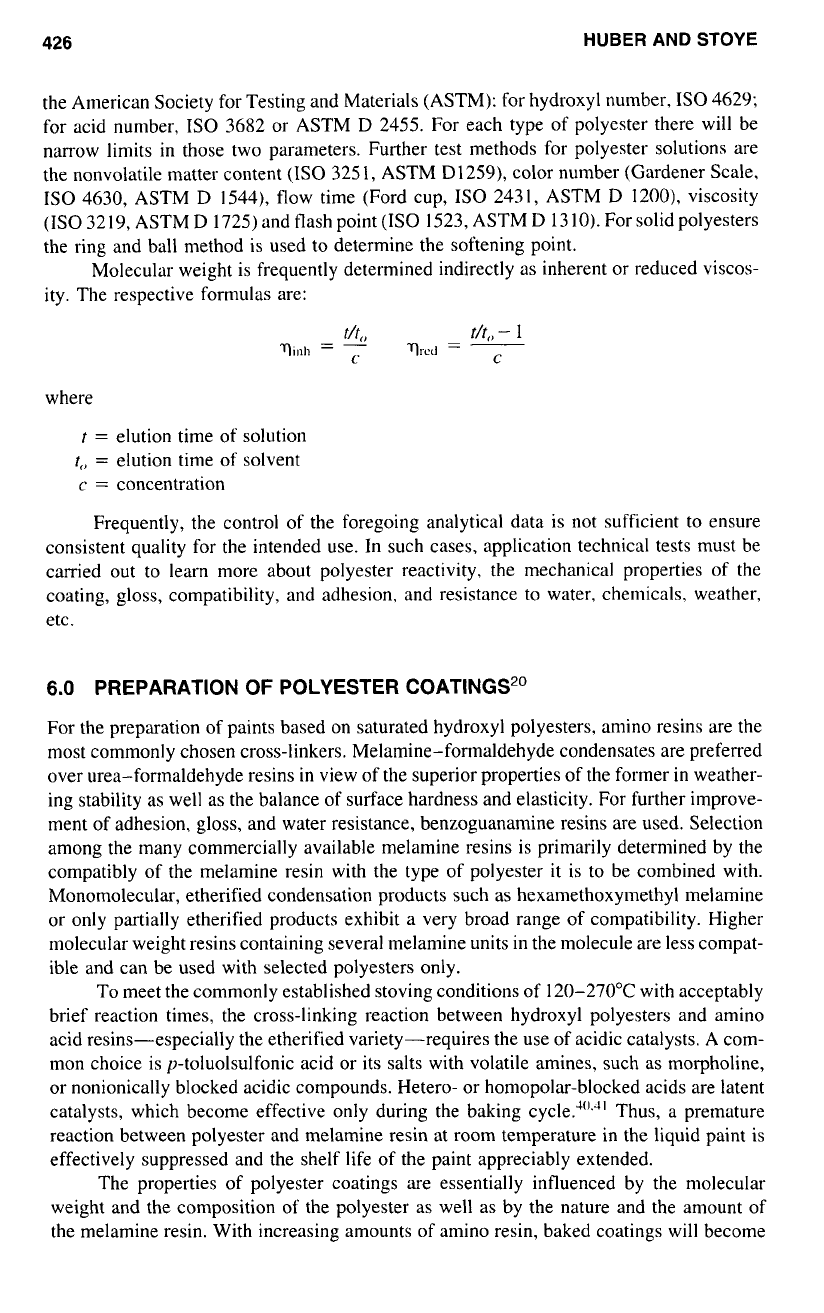
426
HUBER
AND
STOYE
the American Society for Testing and Materials (ASTM): for hydroxyl number,
IS0
4629;
for acid number,
IS0
3682 or ASTM
D
2455. For each type of polyester there will be
narrow limits in those two parameters. Further test methods for polyester solutions are
the nonvolatile matter content
(IS0
325
I,
ASTM
D
1259),
color number (Gardener Scale,
IS0
4630, ASTM
D
1544),
flow time (Ford cup,
IS0
2431, ASTM
D
1200), viscosity
(IS0
3219, ASTM
D
1725)
and flash point
(IS0
1523, ASTM
D
13
IO).
For solid polyesters
the ring and
ball
method is used to determine the softening point.
Molecular weight is frequently determined indirectly as inherent or reduced viscos-
ity.
The respective formulas are:
t/L
t/t(,
-
1
T)lIlh
=
-
T)I-cd
=
c
c
where
t
=
elution time of solution
r,,
=
elution time
of
solvent
c
=
concentration
Frequently, the control
of
the foregoing analytical data is
not
sufficient
to
ensure
consistent quality for the intended use. In such cases, application technical tests must be
carried out to learn more about polyester reactivity, the mechanical properties of the
coating, gloss, compatibility, and adhesion, and resistance to water, chemicals, weather,
etc.
6.0
PREPARATION
OF
POLYESTER
For the preparation of paints based on saturated hydroxyl polyesters, amino resins are the
most commonly chosen cross-linkers. Melamine-formaldehyde condensates are preferred
over urea-formaldehyde resins in view of the superior properties of the former in weather-
ing stability as well as the balance of surface hardness and elasticity. For further improve-
ment of adhesion, gloss, and water resistance, benzoguanamine resins are used. Selection
among the many commercially available melamine resins is primarily determined by the
compatibly of the melamine resin with the type of polyester it is to be combined with.
Monomolecular, etherified condensation products such as hexamethoxymethyl melamine
or only partially etherified products exhibit a very broad range of compatibility. Higher
molecular weight resins containing several melamine units in the molecule are less compat-
ible and can be used with selected polyesters only.
To meet the commonly established stoving conditions of 120-270°C with acceptably
brief reaction times, the cross-linking reaction between hydroxyl polyesters and amino
acid resins-especially the etherified variety-requires the use of acidic catalysts. A com-
mon choice is p-toluolsulfonic acid
or
its salts with volatile amines, such as morpholine,
or nonionically blocked acidic compounds. Hetero- or homopolar-blocked acids are latent
catalysts, which become effective only during the baking Thus, a premature
reaction between polyester and melamine resin at room temperature in the liquid paint is
effectively suppressed and the shelf life of the paint appreciably extended.
The properties of polyester coatings are essentially influenced by the molecular
weight and the composition of the polyester as well
as
by the nature and the amount of
the melamine resin. With increasing amounts of amino resin, baked coatings will become
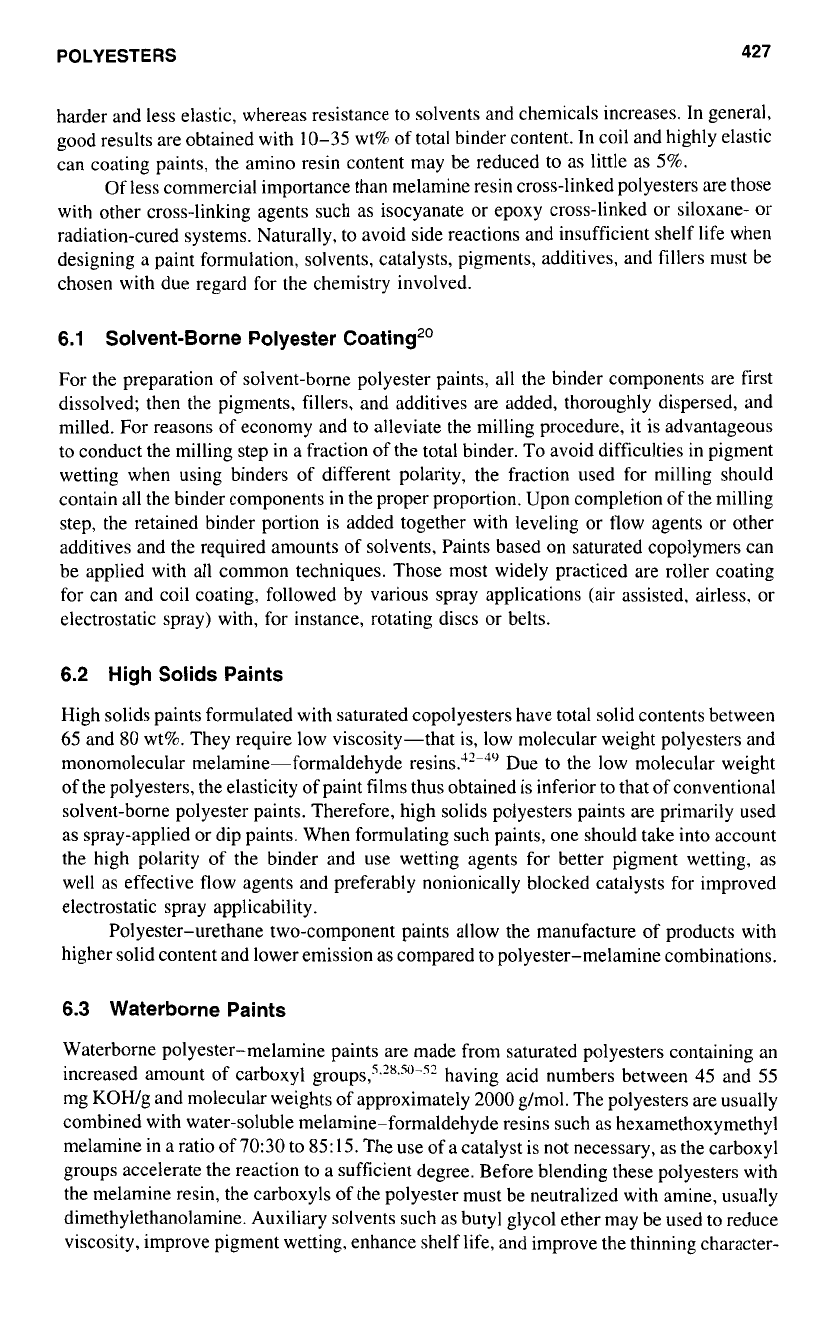
POLYESTERS
427
harder and less elastic, whereas resistance to solvents and chemicals increases. In general,
good results are obtained with
10-35
wt% of total binder content. In coil and highly elastic
can coating paints, the amino resin content may be reduced to as little as
5%.
Of less commercial importance than melamine resin cross-linked polyesters are those
with other cross-linking agents such as isocyanate or epoxy cross-linked or siloxane- or
radiation-cured systems. Naturally,
to
avoid side reactions and insufficient shelf life when
designing a paint formulation, solvents, catalysts, pigments, additives, and fillers must be
chosen with due regard for the chemistry involved.
6.1
Solvent-Borne Polyester Coating*O
For the preparation
of
solvent-borne polyester paints,
all
the binder components are first
dissolved; then the pigments, fillers, and additives are added, thoroughly dispersed, and
milled. For reasons of economy and to alleviate the milling procedure, it is advantageous
to conduct the milling step in
a
fraction of the total binder.
To
avoid difficulties in pigment
wetting when using binders of different polarity, the fraction used for milling should
contain all the binder components in the proper proportion. Upon completion of the milling
step, the retained binder portion is added together with leveling or tlow agents or other
additives and the required amounts of solvents, Paints based on saturated copolymers can
be applied with all common techniques. Those most widely practiced are roller coating
for can and coil coating, followed by various spray applications (air assisted, airless, or
electrostatic spray) with, for instance, rotating discs or belts.
6.2
High Solids Paints
High solids paints formulated with saturated copolyesters have total solid contents between
65
and
80
wt%. They require low viscosity-that is, low molecular weight polyesters and
monomolecular melamine-formaldehyde resins.‘”‘” Due
to
the low molecular weight
of the polyesters, the elasticity of paint films thus obtained is inferior to that of conventional
solvent-borne polyester paints. Therefore, high solids polyesters paints are primarily used
as
spray-applied or dip paints. When formulating such paints, one should take into account
the high polarity of the binder and use wetting agents for better pigment wetting,
as
well
as
effective flow agents and preferably nonionically blocked catalysts for improved
electrostatic spray applicability.
Polyester-urethane two-component paints allow the manufacture of products with
higher solid content and lower emission
as
compared to polyester-melamine combinations.
6.3 Waterborne Paints
Waterborne polyester-melamine paints are made from saturated polyesters containing an
increased amount of carboxyl groups,”’8.s0-’’ having acid numbers between
45
and
55
mg
KOH/g
and molecular weights
of
approximately
2000
g/mol. The polyesters are usually
combined with water-soluble melamine-formaldehyde resins such as hexamethoxymethyl
melamine in a ratio of
70:30
to
85:
15.
The use of
a
catalyst is
not
necessary, as the carboxyl
groups accelerate the reaction to
a
sufficient degree. Before blending these polyesters with
the melamine resin, the carboxyls of the polyester must be neutralized with amine, usually
dimethylethanolamine. Auxiliary solvents such as butyl glycol ether may be used to reduce
viscosity, improve pigment wetting, enhance shelf life, and improve the thinning character-
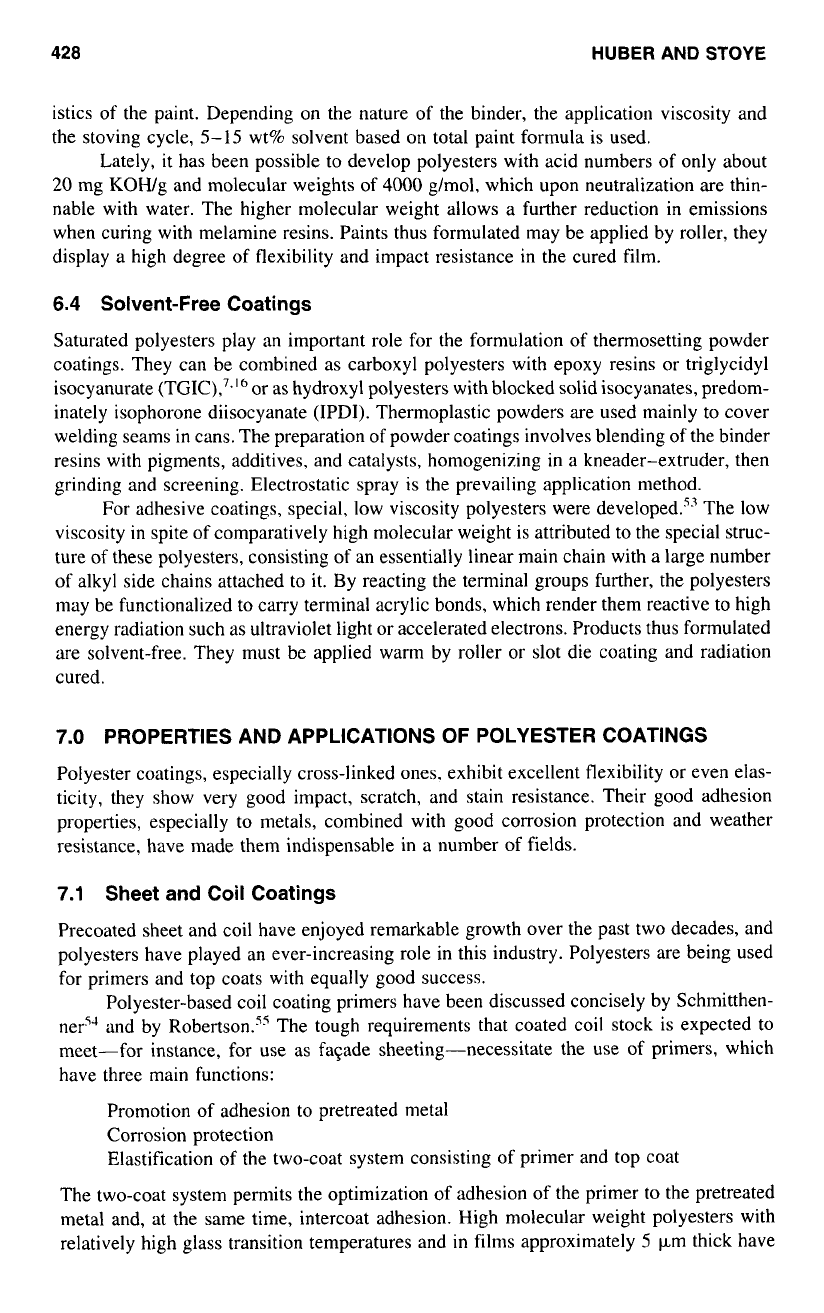
428
HUBER
AND
STOYE
istics of the paint. Depending on the nature of the binder, the application viscosity and
the stoving cycle,
5-15
wt% solvent based on total paint formula is used.
Lately, it has been possible to develop polyesters with acid numbers
of
only about
20
mg KOWg and molecular weights of
4000
g/mol, which upon neutralization are thin-
nable with water. The higher molecular weight allows a further reduction in emissions
when curing with melamine resins. Paints thus formulated may be applied by roller, they
display a high degree
of
flexibility and impact resistance in the cured film.
6.4
Solvent-Free Coatings
Saturated polyesters play an important role for the formulation
of
thermosetting powder
coatings. They can be combined as carboxyl polyesters with epoxy resins or triglycidyl
isocyanurate (TGIC).'.'' or as hydroxyl polyesters with blocked solid isocyanates, predom-
inately isophorone diisocyanate (IPDI). Thermoplastic powders are used mainly to cover
welding seams
in
cans. The preparation of powder coatings involves blending
of
the binder
resins with pigments, additives, and catalysts, homogenizing in a kneader-extruder, then
grinding and screening. Electrostatic spray is the prevailing application method.
For adhesive coatings, special, low viscosity polyesters were developed.s3 The low
viscosity in spite of comparatively high molecular weight is attributed to the special struc-
ture
of
these polyesters, consisting of an essentially linear main chain with a large number
of
alkyl side chains attached to
it.
By reacting the terminal groups further, the polyesters
may be functionalized to carry terminal acrylic bonds, which render them reactive to high
energy radiation such
as
ultraviolet light or accelerated electrons. Products thus formulated
are solvent-free. They must be applied warm by roller or slot die coating and radiation
cured.
7.0
PROPERTIES AND APPLICATIONS
OF
POLYESTER COATINGS
Polyester coatings, especially cross-linked ones. exhibit excellent flexibility or even elas-
ticity, they show very good impact, scratch, and stain resistance. Their good adhesion
properties, especially to metals, combined with good corrosion protection and weather
resistance, have made them indispensable in a number of fields.
7.1
Sheet and Coil Coatings
Precoated sheet and coil have enjoyed remarkable growth over the past two decades, and
polyesters have played an ever-increasing role in this industry. Polyesters are being used
for primers and top coats with equally good success.
Polyester-based coil coating primers have been discussed concisely by Schmitthen-
ner5' and by Robertson.s5 The tough requirements that coated coil stock is expected to
meet-for instance, for use as fagade sheeting-necessitate the use of primers, which
have three main functions:
Promotion of adhesion
to
pretreated metal
Corrosion protection
Elastification of the two-coat system consisting of primer and top coat
The two-coat system permits the optimization of adhesion of the primer
to
the pretreated
metal and, at the same time, intercoat adhesion. High molecular weight polyesters with
relatively high glass transition temperatures and in films approximately
5
km thick have
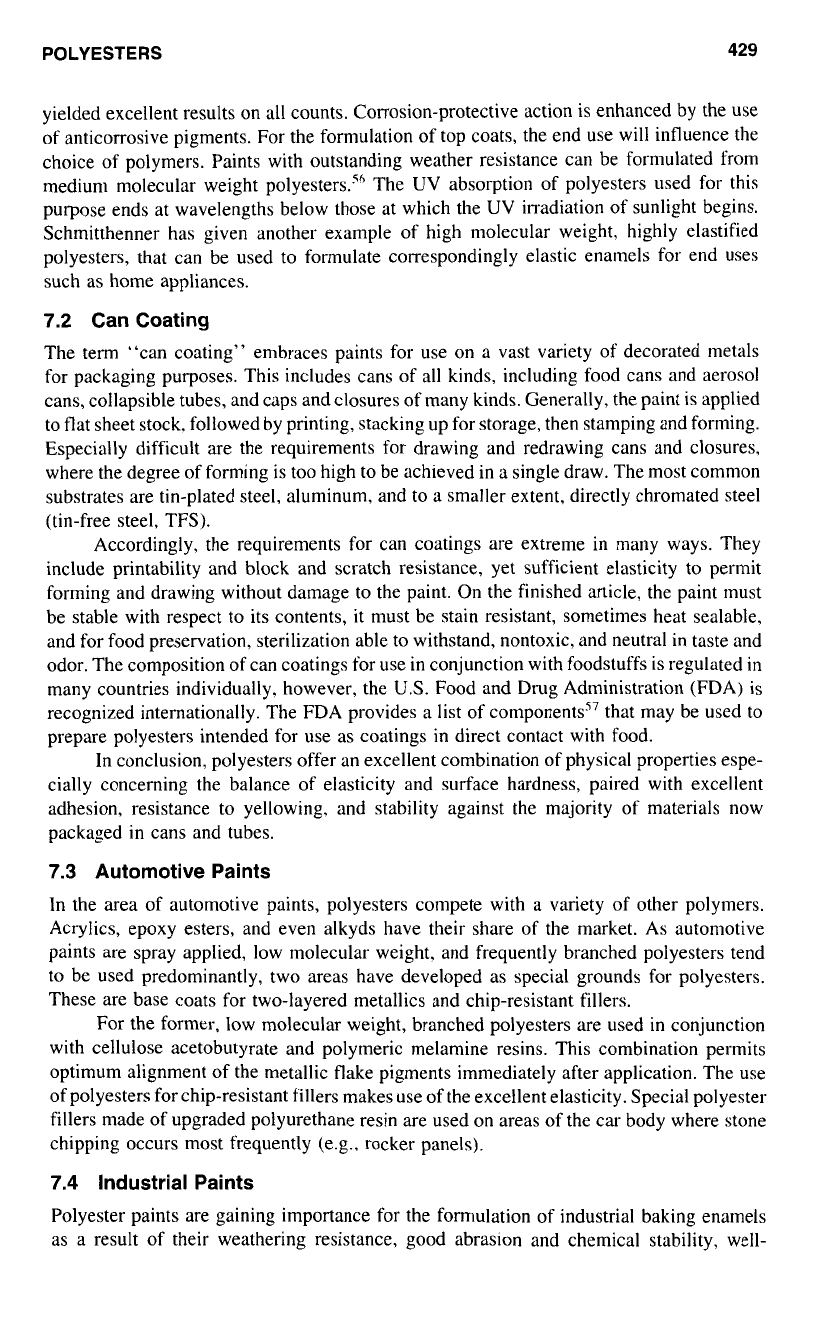
POLYESTERS
429
yielded excellent results on
all
counts. Corrosion-protective action is enhanced by the use
of anticorrosive pigments. For the formulation of top coats, the end use will influence the
choice
of
polymers. Paints with outstanding weather resistance can be formulated from
medium molecular weight polyesters.5h The
UV
absorption
of
polyesters used for this
purpose ends at wavelengths below those at which the
UV
irradiation of sunlight begins.
Schmitthenner has given another example of high molecular weight, highly elastified
polyesters, that can be used to formulate correspondingly elastic enamels for end uses
such as home appliances.
7.2
Can Coating
The term “can coating” embraces paints for use on a vast variety of decorated metals
for packaging purposes. This includes cans of
all
kinds, including food cans and aerosol
cans, collapsible tubes, and caps and closures of many kinds. Generally, the paint is applied
to flat sheet stock. followed by printing, stacking up for storage, then stamping and forming.
Especially difficult are the requirements for drawing and redrawing cans and closures,
where the degree of forming is too high
to
be achieved in a single draw. The most common
substrates are tin-plated steel, aluminum, and
to
a
smaller extent, directly chromated steel
(tin-free steel,
TFS).
Accordingly, the requirements for can coatings are extreme in many ways. They
include printability and block and scratch resistance, yet sufficient elasticity to permit
forming and drawing without damage to the paint. On the finished article, the paint must
be stable with respect to its contents, it must be stain resistant, sometimes heat sealable,
and for food preservation, sterilization able to withstand, nontoxic, and neutral in taste and
odor. The composition of can coatings for use in conjunction with foodstuffs is regulated in
many countries individually. however, the
US.
Food
and Drug Administration (FDA) is
recognized internationally. The FDA provides
a
list of con~ponentss7 that may be used to
prepare polyesters intended for use
as
coatings in direct contact with food.
In conclusion, polyesters offer an excellent combination of physical properties espe-
cially concerning the balance of elasticity and surface hardness, paired with excellent
adhesion, resistance to yellowing, and stability against the majority of materials now
packaged in cans and tubes.
7.3
Automotive Paints
In the area
of
automotive paints, polyesters compete with a variety
of
other polymers.
Acrylics, epoxy esters, and even alkyds have their share of the market. As automotive
paints are spray applied, low molecular weight. and frequently branched polyesters tend
to be used predominantly, two areas have developed
as
special grounds for polyesters.
These are base coats for two-layered metallics and chip-resistant fillers.
For the former,
IOW
molecular weight, branched polyesters are used in conjunction
with cellulose acetobutyrate and polymeric melamine resins. This combination permits
optimum alignment of the metallic flake pigments immediately after application. The use
of polyesters for chip-resistant fillers makes use of the excellent elasticity. Special polyester
fillers made
of
upgraded polyurethane resin are used
on
areas of the car body where stone
chipping occurs most frequently (e.g., rocker panels).
7.4
Industrial Paints
Polyester paints are gaining importance for the formulation of industrial baking enamels
as
a
result
of
their weathering resistance, good abrasion and chemical stability, well-
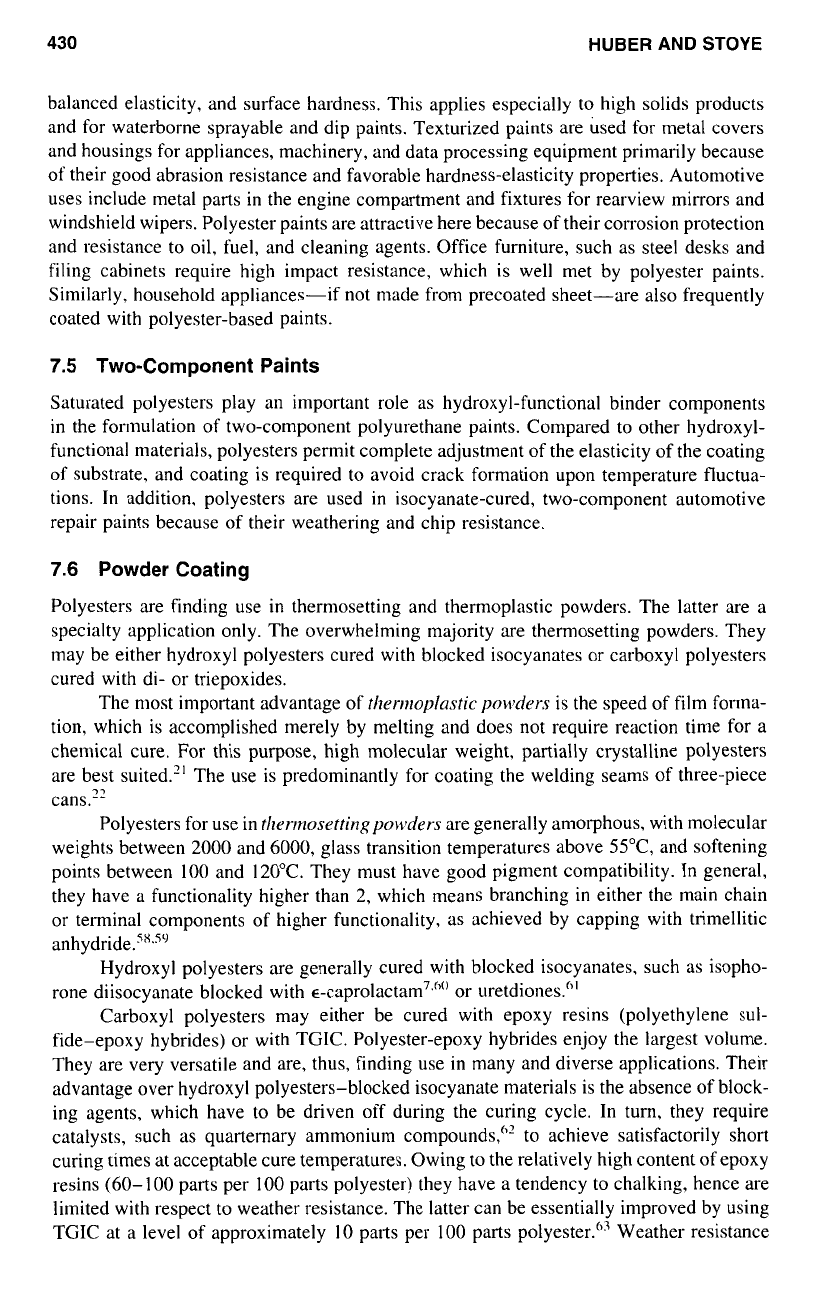
430
HUBERANDSTOYE
balanced elasticity, and surface hardness. This applies especially
to
high solids products
and for waterborne sprayable and dip paints. Texturized paints are used for metal covers
and housings for appliances, machinery, and data processing equipment primarily because
of
their good abrasion resistance and favorable hardness-elasticity properties. Automotive
uses include metal parts
in
the engine compartment and fixtures for rearview mirrors and
windshield wipers. Polyester paints are attractive here because of their corrosion protection
and resistance to oil, fuel, and cleaning agents. Office furniture, such as steel desks and
filing cabinets require high impact resistance, which
is
well met by polyester paints.
Similarly, household appliances-if not made from precoated sheet-are
also
frequently
coated with polyester-based paints.
7.5
Two-Component Paints
Saturated polyesters play an important role as hydroxyl-functional binder components
in the formulation
of
two-component polyurethane paints. Compared to other hydroxyl-
functional materials, polyesters permit complete adjustment
of
the elasticity of the coating
of substrate, and coating is required
to
avoid crack formation upon temperature fluctua-
tions. In addition. polyesters are used
in
isocyanate-cured, two-component automotive
repair paints because of their weathering and chip resistance.
7.6
Powder Coating
Polyesters are finding use in thermosetting and thermoplastic powders. The latter are a
specialty application only. The overwhelming majority are thermosetting powders. They
may be either hydroxyl polyesters cured with blocked isocyanates or carboxyl polyesters
cured with di- or triepoxides.
The most important advantage of
rhen~zoplastic
powders
is the speed of film forma-
tion, which is accomplished merely by melting and does not require reaction time for a
chemical cure. For this purpose, high molecular weight, partially crystalline polyesters
are best suited." The use is predominantly for coating the welding seams
of
three-piece
cans.??
Polyesters for use in
t1zrrtnosetfinl:pol~tders
are generally amorphous, with molecular
weights between 2000 and 6000, glass transition temperatures above %"C, and softening
points between
100
and 120°C. They must have good pigment compatibility. In general,
they have a functionality higher than 2, which means branching
in
either the main chain
or terminal components of higher functionality, as achieved by capping with trimellitic
Hydroxyl polyesters are generally cured with blocked isocyanates, such as isopho-
rone diisocyanate blocked with
c caprolactam'^"^)
or uretdiones."'
Carboxyl polyesters may either be cured with epoxy resins (polyethylene sul-
fide-epoxy hybrides) or with TGIC. Polyester-epoxy hybrides enjoy the largest volume.
They are very versatile and are, thus, finding use in many and diverse applications. Their
advantage over hydroxyl polyesters-blocked isocyanate materials is the absence of block-
ing agents, which have
to
be driven off during the curing cycle. In turn, they require
catalysts, such as quarternary ammonium compounds,"' to achieve satisfactorily short
curing times at acceptable cure temperatures. Owing to the relatively high content of epoxy
resins
(60-1
00 parts per
100
parts polyester) they have a tendency
to
chalking. hence are
limited with respect to weather resistance. The latter can be essentially improved by using
TGIC at
a
level
of
approximately
IO
parts per
100
parts polyester."3 Weather resistance
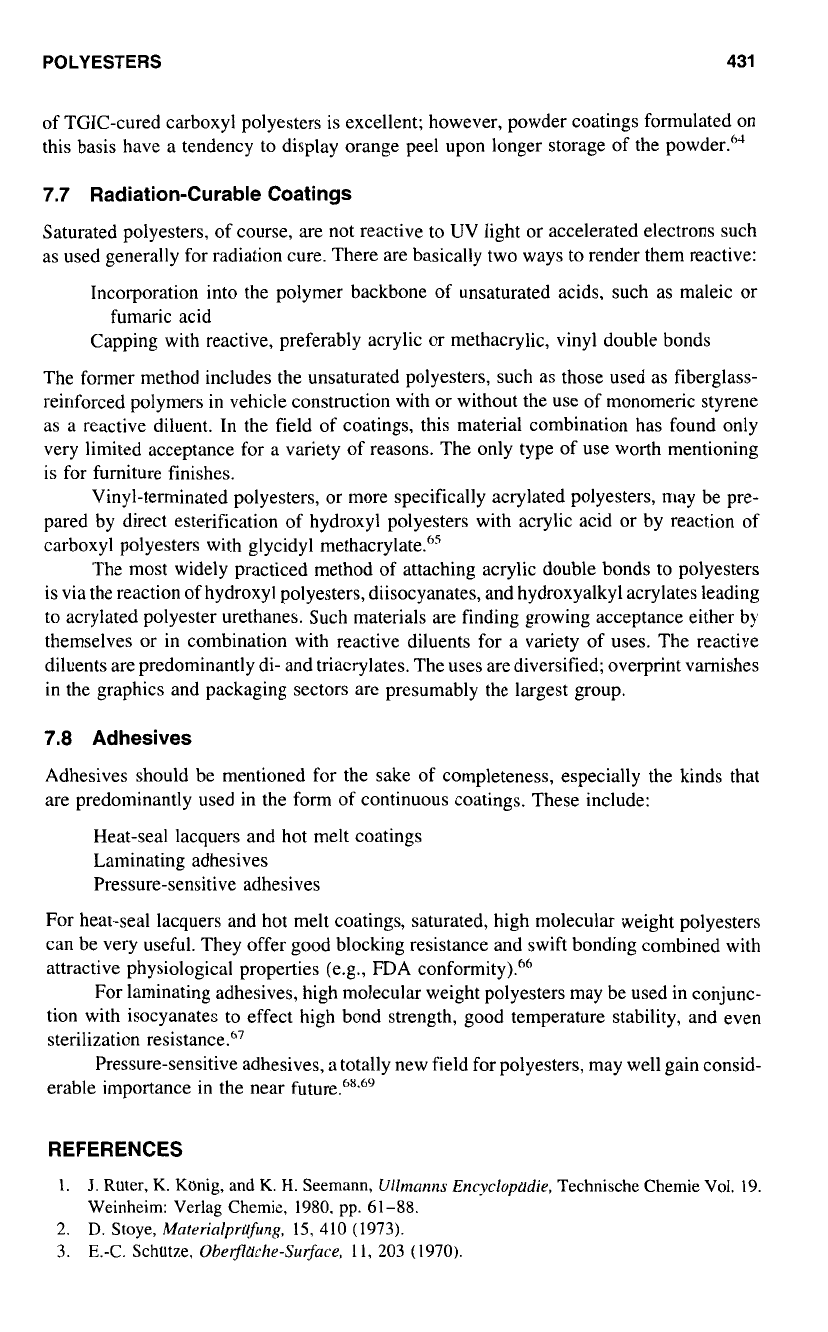
POLYESTERS
431
of TGIC-cured carboxyl polyesters is excellent; however, powder coatings formulated on
this basis have a tendency to display orange peel upon longer storage of the powder."'
7.7
Radiation-Curable Coatings
Saturated polyesters, of course, are not reactive
to
UV light or accelerated electrons such
as used generally for radiation cure. There are basically two ways to render them reactive:
Incorporation into the polymer backbone
of
unsaturated acids, such as maleic
or
Capping with reactive, preferably acrylic or methacrylic, vinyl double bonds
The former method includes the unsaturated polyesters, such as those used as fiberglass-
reinforced polymers in vehicle construction with or without the use of monomeric styrene
as
a reactive diluent. In the field of coatings, this material combination has found only
very limited acceptance for
a
variety of reasons. The only type of use worth mentioning
is for furniture finishes.
Vinyl-terminated polyesters, or more specifically acrylated polyesters, may be pre-
pared by direct esterification of hydroxyl polyesters with acrylic acid or by reaction of
carboxyl polyesters with glycidyl methacrylate."'
The most widely practiced method
of
attaching acrylic double bonds to polyesters
is via the reaction of hydroxyl polyesters, diisocyanates, and hydroxyalkyl acrylates leading
to acrylated polyester urethanes. Such materials are finding growing acceptance either by
themselves or in combination with reactive diluents for a variety
of
uses. The reactive
diluents are predominantly di- and triacrylates. The uses are diversified; overprint varnishes
in
the graphics and packaging sectors are presumably the largest group.
fumaric acid
7.8
Adhesives
Adhesives should be mentioned for the sake
of
completeness, especially the kinds that
are predominantly used in the form of continuous coatings. These include:
Heat-seal lacquers and hot melt coatings
Laminating adhesives
Pressure-sensitive adhesives
For heat-seal lacquers and hot melt coatings, saturated, high molecular weight polyesters
can be very useful. They offer good blocking resistance and swift bonding combined with
attractive physiological properties (e.g., FDA conformity)."
For laminating adhesives, high molecular weight polyesters may be used in conjunc-
tion with isocyanates to effect high bond strength, good temperature stability, and even
sterilization re~istance.'~
Pressure-sensitive adhesives,
a
totally new field for polyesters, may well gain consid-
erable importance in the near
REFERENCES
1.
J.
Ruter,
K.
Kanig,
and
K.
H.
Seemann,
Ullrnanns
Encyclopddie,
Technische Chemie Vol.
19.
2.
D.
Stoye,
Matrrialprllfung,
15,
410
(1973).
3. E.-C. Schutze,
Oberj?'dche-Surface,
1
I,
203 (1970).
Weinheim: Verlag Chemie, 1980.
pp.
61-88.
